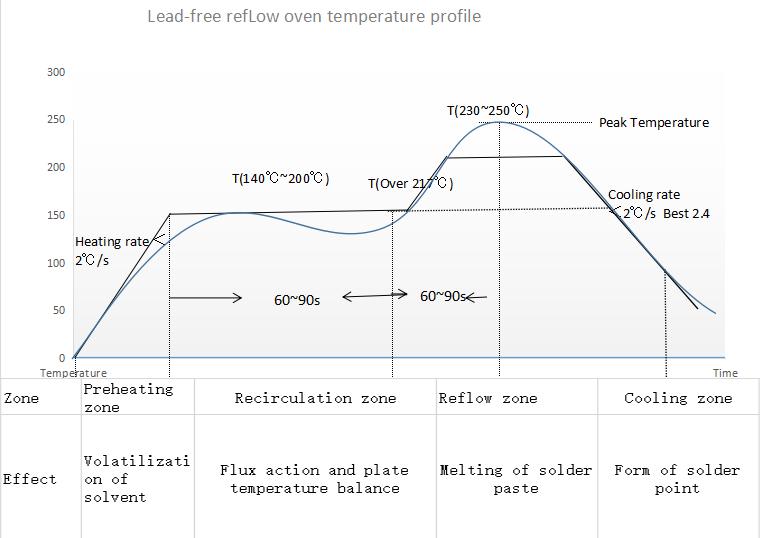86-571-26265158
The reflow oven temperature curve refers to the curve of the temperature of a certain point on the SMA with time when the SMA passes through the reflow oven furnace. The temperature curve provides an intuitive method to analyze the temperature change of a component during the entire reflow soldering process. This is very useful for obtaining the best solderability, avoiding damage to components due to over-temperature, and ensuring soldering quality. The reflow oven temperature setting is to set the reflow oven temperature curve.

Figure 1 Reflow oven temperature curve
1. Temperature setting method of reflow oven preheating section:
The purpose of this area is to heat the PCB at room temperature as soon as possible to achieve the second specific goal, but the heating rate must be controlled within an appropriate range. If it is too fast, the thermal shock will occur, and the circuit board and components may be damaged and too slow. The solvent volatilization is insufficient, which affects the welding quality. Due to the faster heating rate, the temperature difference in the latter section of the SMA is larger. To prevent thermal shock from damaging the components. Generally, the maximum speed is 4°C/S. However, the ascent rate is usually set to 1~3°C/S. The typical temperature rise rate is 2°C/S.
2. Temperature setting method of reflow oven insulation section:
The heat preservation section of the reflow oven refers to the area where the temperature rises from the melting point of the solder paste from 120°C to 150°C. The main purpose of the heat preservation section is to stabilize the temperature of each element in the SMA and minimize the temperature difference. Give enough time in this area to make the temperature of the larger component catch up with the smaller component, and to ensure that the flux in the solder paste mixer is fully volatilized. At the end of the heat preservation section, the oxides on the pads, solder balls, and component pins are removed, and the temperature of the entire circuit board reaches equilibrium.
3. The temperature setting method of the reflow section of the reflow oven:
In this area, the heater temperature is set high, so that the temperature of the component rises rapidly to the peak temperature. In the reflow section, the peak soldering temperature varies depending on the solder paste used. Generally, the recommended solder paste is the melting point temperature of the solder paste plus 20-40°C. For 63Sn/37Pb solder paste with a melting point of 183°C and a melting point of 179°C For Sn62/Pb36/Ag2 paste soldering, the peak temperature is generally 210-230°C, and the reflow time should not be too long to prevent adverse effects on SMA. The ideal temperature profile is the small volume covered by the "end zone" that exceeds the melting point of the solder.
4. Temperature setting method of the reflow oven cooling section:
In this paragraph, the lead-tin powder in the solder paste has melted and fully wetted the surface to be connected. It should be cooled as fast as possible, which will help to obtain bright solder joints with good appearance and low contact. angle. Slow cooling will cause more decomposition of the circuit board into the tin, resulting in dull and rough solder joints. In the case of the end, it can cause poor soldering and weak solder joint adhesion. The cooling rate of the cooling section is generally 3~10°C/S, and it can be cooled to 75°C.